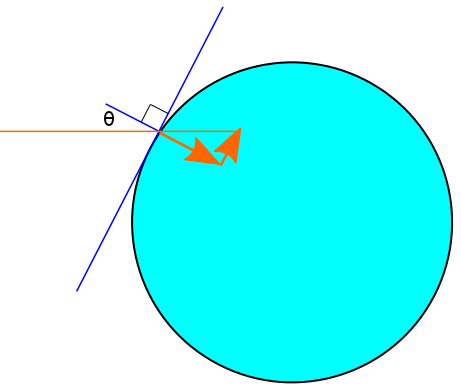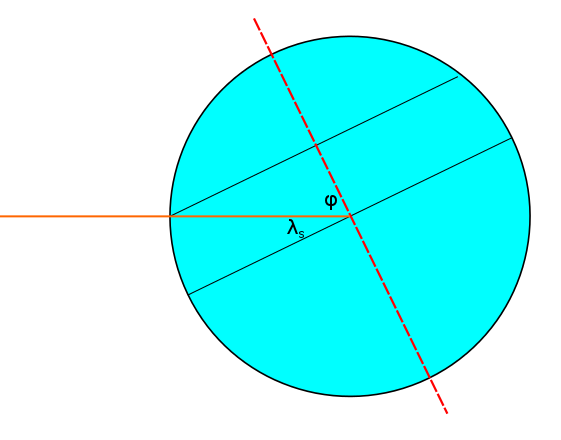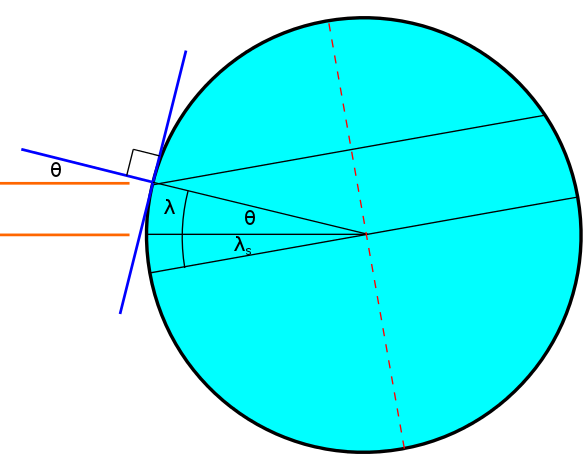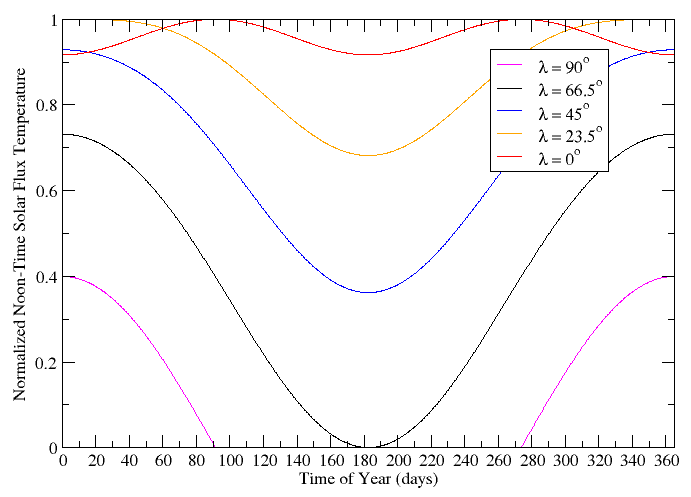Main menu
You are here
It's Getting Hot In Here
In a recent post, we used trigonometry to derive the length of a day on the Earth as a function of the observer's latitude and the time of year. As promised, I want to continue modelling the Earth's orbit to see what it can tell us about temperature. The simplest explanation for the seasonal variation of temperature comes from the concept of solar flux. To see what this means, think about taking a ray of sunlight shining on the Earth and decomposing it into two components - one parallel to the Earth's surface and one perpendicular.

Most of the sunlight going into the ground means this location will be hot, whereas most of the sunlight going along the ground means this location will be cold. The temperature due to direct sunlight is therefore proportional to the cosine of the angle between the ray and the outward normal to the Earth. To actually solve for a temperature, we would have to multiply the intensity of the light by  and integrate this over a region of interest. Our main concern will be solving for
and integrate this over a region of interest. Our main concern will be solving for  , allowing us to express the temperature at one time relative to the temperature at another time without knowing the absolute intensity.
, allowing us to express the temperature at one time relative to the temperature at another time without knowing the absolute intensity.
To do this, we need a method for keeping track of the Sun's position in the sky. We can do this using the familiar angles of latitude and longitude. This standard geographic co-ordinate system projected onto the sky is called the celestial sphere. If the Sun has a latitude of  and a longitude of
and a longitude of  on the celestial sphere, this means that the location on Earth having
on the celestial sphere, this means that the location on Earth having  latitude and
latitude and  longitude will see the Sun as being directly overhead. Astronomers would instead say that the Sun has a
longitude will see the Sun as being directly overhead. Astronomers would instead say that the Sun has a  declination and a
declination and a  right ascension but for all intents and purposes, this means the same thing.
right ascension but for all intents and purposes, this means the same thing.
At any point in time, there is a "sunny spot" - a latitude and longitude on the Earth where the Sun is directly overhead. We will denote this point by  . In the following diagram, we see two angles, the sunny latitude and the angle between a direct sun ray and the Earth's axis. This was a very important angle in the last post which we called
. In the following diagram, we see two angles, the sunny latitude and the angle between a direct sun ray and the Earth's axis. This was a very important angle in the last post which we called  . The formula we had before said that
. The formula we had before said that  where
where  is 365.24 days,
is 365.24 days,  is the inclination of the Earth's axis and
is the inclination of the Earth's axis and  . Together,
. Together,  and
and  form a right angle, so the formula we are looking for is
form a right angle, so the formula we are looking for is  .
.

Naturally, the sunny latitude must be somewhere between the Tropic of Cancer and the Tropic of Capricorn. The sunny longitude simply goes from  to
to  in the course of a day so a possible formula for it would be
in the course of a day so a possible formula for it would be  where
where  is 24 hours. This formula however, is naive because after many days, the sunny longitude at the beginning of the day will be affected by the Earth's orbit. The offset this introduces is
is 24 hours. This formula however, is naive because after many days, the sunny longitude at the beginning of the day will be affected by the Earth's orbit. The offset this introduces is  , giving us:
, giving us:
![\[ \left ( \lambda_{\textup{s}}(t), \phi_{\textup{s}}(t) \right ) = \left ( \arcsin \left ( \cos \left ( \frac{\tau t}{T_1} \right ) \sin \delta \right ), \tau t \left ( \frac{1}{T_1} + \frac{1}{T_2} \right ) \right ) \]](/sites/default/files/tex/8600268614d365cc973c54ee62d55bc2846eef28.png) |
When I first wrote down this function for tracking the position of the Sun with time, I first asked myself is it injective? It is actually not. In a given year, there are a few moments in time that allow the Sun's position at that time to be revisited once again in the same year. Let's demand that the latitudes be equal at times  and
and  . This gives us:
. This gives us:
 |
Demanding the same thing for the longitudes gives us:
 |
where  is the harmonic mean of
is the harmonic mean of  and
and  - approximately 23.9 hours. Putting these together, we see that if the time is a half-integer multiple of
- approximately 23.9 hours. Putting these together, we see that if the time is a half-integer multiple of  before the midpoint of a year, we will get another chance to see the Sun in the same place if we wait for the same half-integer multiple of
before the midpoint of a year, we will get another chance to see the Sun in the same place if we wait for the same half-integer multiple of  after the midpoint of that year. One thing I might try to do is use this information to time a visit to the Canadian War Museum in Ottawa. The window in Memorial Hall is positioned so that it will be illuminated at 11 a.m. on November 11. In order to see it light up at a different time, I could try going at 1 p.m. on February 19. Results will probably vary because how close this hour is to one of the special hours depends heavily on the leap-year cycle.
after the midpoint of that year. One thing I might try to do is use this information to time a visit to the Canadian War Museum in Ottawa. The window in Memorial Hall is positioned so that it will be illuminated at 11 a.m. on November 11. In order to see it light up at a different time, I could try going at 1 p.m. on February 19. Results will probably vary because how close this hour is to one of the special hours depends heavily on the leap-year cycle.
Before I got distracted, the original purpose of this was to calculate  but we should not keep saying
but we should not keep saying  because the flux is only proportional to this number when we are talking about the light side of the Earth. When the angle
because the flux is only proportional to this number when we are talking about the light side of the Earth. When the angle  puts us on the dark side of the Earth, the flux is zero. So the function we are really trying to find is not
puts us on the dark side of the Earth, the flux is zero. So the function we are really trying to find is not  but
but  . Note that this does not mean that the temperature is zero. The flux of sunlight is only one of the factors determining temperature. The Earth's atmosphere does a good job of ensuring that places still stay relatively warm during the night. If we were on a planet with no atmosphere, nightfall really would bring about a huge drop in temperature. The next diagram shows a situation in which the Sun is just barely able to deliver a non-zero flux.
. Note that this does not mean that the temperature is zero. The flux of sunlight is only one of the factors determining temperature. The Earth's atmosphere does a good job of ensuring that places still stay relatively warm during the night. If we were on a planet with no atmosphere, nightfall really would bring about a huge drop in temperature. The next diagram shows a situation in which the Sun is just barely able to deliver a non-zero flux.

For the location in this picture, the Sun has either just risen or is just about to set. If we assume that the Sun is very far away, the Sun will stay in the field of view until we move to the "very top" of the circle or the "very bottom". We will now use this approximation to solve for the flux at noon for an arbitrary latitude.

When we solve for the flux at solar noon, we only have to worry about the latitude of the observer. The longitude will be equal to  . The diagram above makes it clear that
. The diagram above makes it clear that  . This relies on the fact that the orange lines are parallel which is only true if we make the approximation that the Sun is infinitely far away. Making substitutions, we see that our flux is:
. This relies on the fact that the orange lines are parallel which is only true if we make the approximation that the Sun is infinitely far away. Making substitutions, we see that our flux is:
 |
The thing we must do now is plot this function. Again, the plot confirms many intuitive things. The equator achieves the maximum temperature of one on each solstice but any other latitude between the tropics does too. In order to see days in which the warmest temperature might still be zero, we have to go above the Arctic circle or below the Antarctic circle. In other words this is equivalent to finding locations with 24 hour night.

We solved for  but a more general quantity to calculate is
but a more general quantity to calculate is  . If you have forced yourself to visualize all of the operations up to this point, it is not too hard to see that we start off on the ray of sunlight, rotate through an angle of
. If you have forced yourself to visualize all of the operations up to this point, it is not too hard to see that we start off on the ray of sunlight, rotate through an angle of  in one plane and then rotate in an orthogonal plane until we get to a longitude of
in one plane and then rotate in an orthogonal plane until we get to a longitude of  . Recalling the sunrise post, we did something very similar. We derived a relationship between the angles
. Recalling the sunrise post, we did something very similar. We derived a relationship between the angles  ,
,  and
and  . The exact same relationship holds between
. The exact same relationship holds between  ,
,  and
and  - the cosine of the first is equal to the cosine of the second times the cosine of the third. All in all, we have:
- the cosine of the first is equal to the cosine of the second times the cosine of the third. All in all, we have:
![\begin{align*} \cos \theta(\lambda, \phi, t) &= \cos \left ( \lambda - \lambda_{\textup{s}}(t) \right ) \cos \left ( \phi - \phi_{\textup{s}} \right ) \\<br />
&= \left [ \cos \lambda \sqrt{1 - \cos^2 \left ( \frac{\tau t}{T_1} \right ) \sin^2 \delta} + \sin \lambda \cos \left ( \frac{\tau t}{T_1} \right ) \sin \delta \right ] \cos \left ( \phi - \tau t \left ( \frac{1}{T_1} + \frac{1}{T_2} \right ) \right )<br />
\end{align*}](/sites/default/files/tex/be6f5464f701f0492c35b08600a5b2abae726fe2.png) |
If you want this presented visually, you'll have to do it because I cannot think of a nice way to plot this beast.
